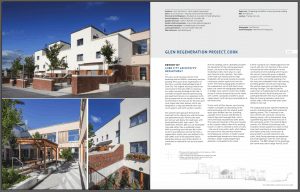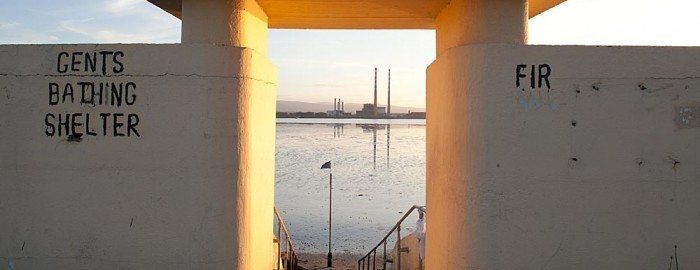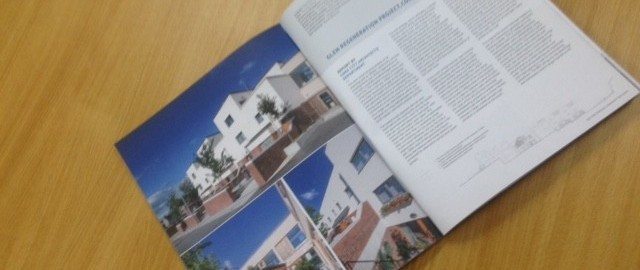-
More Than Concrete Blocks
More than Concrete Blocks: Dublin City’s twentieth-century buildings was launched with great excitement last week. The book is the culmination of almost five years of work. Most of the new architectural photography was commissioned by Dublin City Council for this project. The book provides an authoritative account of Dublin’s social, cultural and political history. The built history is used as evidence in the account of the century. The book is a brilliant and entertaining guide to the 20th century Dublin. It is a must have for anyone interested in Dublin, Architecture and any type of social History
More than Concrete Blocks: Dublin City’s twentieth-century buildings is a three-volume series of architectural history books which are richly illustrated and written for the general reader. Unpacking the history of Dublin’s architecture during the twentieth century, each book covers a period in chronological sequence: Volume I, 1900–40; Volume II, 1940–73; Volume III, 1973–2000. The series considers the city as a layers and complex place. It makes links between Dublin’s buildings and Dublin’s political, social, cultural and economic histories.
http://www.fourcourtspress.ie/books/2016/more-than-concrete-blocks/
-
Buying a camera for Architectural photography PART 1
Buying a Camera for Architectural Photography
Sometimes I’m asked what would be a good camera for architectural photography.
How will you use the camera? is the first question to ask when you are thinking about buying. Most people have diverse interests. They will what a camera that matches those interests. For many it is pictures of friends, family, landscapes, travel, a bit of architecture and occasional sunset. Portability is a bonus, and expense a concern.
My personal belief is that the best type of camera is one that you can pop in a pocket and bring with you everywhere. The old joke is : ” The best camera is the camera you have with you”. For this reason smart phone cameras have much to offer. I have listed the types of suitable camera and their advantages and disadvantages.
My recommendations :
- 1. Smart phone
- 2. Compact digital camera
- 3. Micro 4/3 ( Four Thirds)
- 4. Cropped frame Digital SLR
- 5. Full Frame Digital SLR
For most photography I would recommend getting the most portable camera that you feel comfortable with. The reason is that many people leave their “good” camera behind on day trips because of the weight of the camera. A heavy camera and a bag of lens with a tripod can weight up to 10kg. Photography should be about creative image making not weight lifting.
1. Smart Phone
Smart phones bring high resolution, high quality images to everyone. They make sharing images and editing images a pleasure. They do have some limitations:
- Smart phones use a very small image chip, because of this they will always have a very long depth of field ( this can be a good thing for some photography).
- The user interface on smart phones can be a bit difficult to use, a dedicated camera functions better as a camera.
- The camera function on smart phones can be very slow also, not so good for candid pictures.
- The optics on smart phones are never as good as a dedicated camera.
- Smart phones can be expensive costing from 200 to 1000 euro/ dollars.
- Smart phones have to be charged every day, most dedicated cameras will have a good battery life.
They do have some advantages over traditional cameras:
- All images will have GPS data embedded in the images, this is an advantage if you are trying to find images or locations at a later date
- Many smart phones will provide automatic backup to the cloud for all your images
- The remote cloud access means that you can access your images from any location
- Many people bring their phone everywhere
- The ability to share and edit images is a very attractive feature that allows social engagement
- The small chip will give a very long depth of field, this can be great if you are photographing an architectural model ( its not so good for portraiture)
2. Compact Digital Camera
Most digital compact cameras produce amazing images. Compact digital cameras present a huge advantage of portability. Personally I feel this is of huge importance, how many times have I left my “good” camera at home because I didn’t want to carry it with a bag of lens around all day. Many of the top line compact cameras will offer comparable image quality to a digital SLR. A summary of compact camera advantages:
- Compact, this means that you’re more likely to bring it with you
- Sealed chip and lens unit, this means that dust will not get into the chip
- Many cameras offer a zoom that will give a good range of focal lengths from wide angle to telephoto .
- The best brands offer fantastic image quality, Olympus, Nikon, Fuji, Sony, Canon
- Many offer built in “effects” modes, producing convincing black and white, retro or positive film effects.
- Many will have a built in flash
The disadvantages of a compact camera are:
- Many compact cameras don’t offer a zoom that is sufficiently wide angle lens to be of use to those interested architecture ( but many will have a panorama function)
- The zoom lens in a compact camera tend to be mechanically powered which can sometimes be very slow to operate
- Optically the lenses tend to be very good, however the chip size on a compact camera is not the best for portraiture
- The mental connection between photography and cameras and photography has been replaced by a connection between a mental photography and the smart phone. Nowadays when we want to remember that we want to take ” good” photography we have to actively compel ourselves to bring the “good” camera. As a result the good camera is frequently left behind.
- At present compact cameras don’t tend to have the social, cloud backup features of smart phones, but that is changing
3,4,5 Micro 4/3 rds cameras, Cropped and Full frame Digital camera
All of these types of cameras offer better camera and optical performance, but the big trade-off is portability, weight and convenience. Personally I feel that the trade-off can be too high. DSLR’s are sometimes so expensive/heavy/complicated that they discourage use.
The big advantages of DSLR’s are:- Superior optics ( but only if you invest in good lenses).
- Bigger chip, is better for portrait photography.
- Higher resolution.
- A full system of accessories etc.
- They are a serious camera, if you’re using one there is a tenacity to dedicate more time and concentration to the photography.
The disadvantages are:
- Expense.
- Not portable.
- To get the best out of the camera they frequently require a tripod.
- Generally no flash on the higher end models.
- To get the very best out of the image they require a considered and methodical approach to image making.
- If the lens is detachable the chip can get covered in dust.
In summary of the above, if you want to upgrade your architectural photography I would recommend a good compact camera over a DSLR. Others will disagree no doubt. If you have about 30000 euro to burn you could also opt for someone from this company.
-
Rooms / Room
Rooms by Declan O’Donnell is on sale now.
This book is full of ideas renovating or improving your home. The format catalogues each room in the house. It gives a selection of realistic but imaginative ideas for all the rooms in the house. Some of the design inspiration comes from projects I have photographed over the years. One particularly impressive project is by Michael DeSuin of DeSuin Sullion Architects , the project can be seen here on there website. Or more images can be seen on my site here
You can even buy it with Room by Emma Donoghue on Easons.
http://www.riai.ie/news/article/riai_bookshop_book_of_the_weekrooms_create_the_home_you_want_for_your_life
-
R.I.A.I. Architecture Awards
The R.I.A.I. Architectural Awards has announced the awards deadline. Mark Thursday April the 7th in your diary for the awards submission date.
If you’re thinking of entering the awards you should plan to have your presentation prepared one week in advance.
Enter Now to the 2016 RIAI Irish Architecture Awards.
Now in their 27th year, the RIAI Irish Architecture Awards celebrate the best architecture in Ireland and around the world. Winning projects reflect quality and advances in architecture, and show the value that architecture adds to society across a range of typologies.
Why Should I Enter?
Why Should I Enter?
The RIAI Awards are judged by an expert jury of award-winning architects and renowned assessors.
The RIAI Irish Architecture Awards are accompanied by an effective and far-reaching national media campaign. Traditionally, the winner of the Public Choice Award has been announced on RTE Radio One Morning Ireland while RTE Six One News has covered the awards for television. In addition, there has been substantial media coverage in national and regional newspapers as well as regional radio. The audience reach in 2015 has been over 2 million.
The RIAI Awards are accompanied by a Digital Marketing and Social Media campaign.
The RIAI Awards are accompanied by in-depth publication in Architecture Ireland and The RIAI Annual Review.
The RIAI Awards are accompanied by a public engagement programme – our Walks + Talks of award-winning buildings, led by the architects.
What’s New in 2016?
In 2016 we are developing the RIAI Awards further to enhance their role and impact, including with a new venue and format. We are also introducing new two award categories:
- Best Fit-out Award
- A Student Award for Sustainable Design in partnership with the RIAI Sustainability Task Force
Key Dates for 2016
February – Call for Entries RIAI Awards 2016
April 7 – Submission date for RIAI Awards 2016 (post Easter)
May – Jury Assessment and Public Choice Award
June 24 – Awards Ceremony Date 2016
-
Architecture Ireland Housing Edition
Architecture Ireland recently published an edition on housing. The Glen Regeneration project completed by Cork City Council is featured in the edition. Photographs of the project were completed last summer on a glorious day. The project is a great example of housing in the landscape. Cork’s steep slopes are made use of by the Architects to create a patterned landscape of housing across the hills cape. The slope enables courtyards at the front of some houses that have bridges into the main accommodation.



image of architecture ireland magazine showing the Glen Regeration Architectural Photography Cork Ireland



